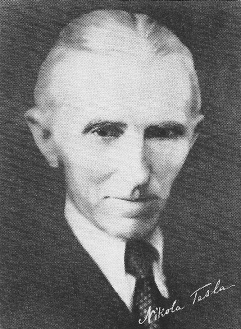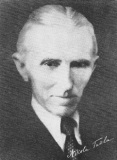|
April 1963 Radio-Electronics
 [Table of Contents] [Table of Contents]
Wax nostalgic about and learn from the history of early electronics.
See articles from Radio-Electronics,
published 1930-1988. All copyrights hereby acknowledged.
|
This brief biography of Nikola
Tesla was printed in a 1963 issue of Radio-Electronics magazine. Tesla
was considered an enigmatic and mysterious person. For someone deemed to be a loner
and recluse, he sure managed to accomplish a lot for the world of science considering
his humble beginnings in Yugoslavia as the son of a clergyman (a lot of Europe's
great scientists were in church service to some capacity). Tesla emigrated to America
in 1884 "with 4¢ in his pocket," which is the equivalent of about a buck and
a half today - basically nothing. Maybe he also had money in his shoe or suitcase
;-) As was the case with many highly successful inventors, he fought many
legal, publicity, and philosophical battles in his lifetime, the most famous of
which was "The War of the Currents,"
where he, in legion with George Westinghouse, had his alternating current (AC) power
distribution system pitted against none other than Thomas Edison who promoted a
direct current (DC) distribution system - and won.
See
Nikola Tesla in 19th Century Newspapers,
Nikola
Tesla - Master of Lightning, and
Inventors of Radio: Nikola Tesla,
The War of the Currents
Inventors of Radio: Nikola Tesla
 By Dexter S. Bartlett By Dexter S. Bartlett
Nikola Tesla was an extremely visionary person - even bordering on the neurotic
- who had the uncanny habit of making most of his visions come true. This is attested
to by the more than 900 patents to his credit, many of which were fundamental. His
other visions were mostly ahead of his time. Like others who have accomplished things,
he preferred his workshop to society.
Nikola Tesla was born in Smiljan, Lika, in what is now Yugoslavia, in 1856. He
was the son of a clergyman and Georgiana Maudic, herself not unknown as an inventor.
After completing his primary education, his parents wanted him to enter the church
but he prevailed upon them to send him to the Polytechnic at Gratz. There he studied
mathematics for four years, followed by two years of philosophical studies at the
University of Prague. He died in New York on Jan. 7, 1943.
He developed his first invention, a telephone repeater, in 1881, and conceived
his idea of the rotating magnetic field which was to be the basis of his famous AC transmission of power. He then traveled in France and Germany, and finally settled
down in the United States. He was attracted to America by the remarkable progress
of the electrical industry, and with 4 cents in his pocket, stepped off the boat
at New York City's Battery in 1884. America as a land of opportunity was soon apparent,
for as he walked up Broadway he met a group of men trying to repair an electric
motor. They paid him for fixing it. He proceeded with high hopes of finding work
with Edison. His luck continued; Edison gave him a job in his laboratory at Orange,
N.J., designing motors and generators.

The Tesla coil, source of extremely high voltage.
After some time with Edison, designing motors and generators, Tesla began to
have visions of high-voltage AC transmission lines covering the nation, while Edison
still claimed that DC power was the only logical way. So in 1887 Tesla started his
Tesla Electric Co. This was not much of a success and he soon sold his patents to
Westinghouse for a good sum. His polyphase AC transmission system was the first
used between Niagara Falls and Buffalo - the great granddaddy of all power networks
of this day.
Among his many wireless telegraph patents are a rotary spark gap; a coherer in
which filings were placed in a chamber exhausted of air, decohered by revolving
it constantly; a tikker or loose contact detector; filament-less lamps or neon-like
tubes, and suggestions for the instigation of the first time ticks from the Eiffel
Tower, made by General Ferrie in 1909.
In 1891, he showed that it was possible to transmit energy through a single wire,
without return. In the same year he invented his justly famous Tesla transformer
(Tesla coil) which demonstrated the effects and phenomena connected with high-frequency
oscillators. Although this transformer has remained mostly a scientific toy, it
is still used to demonstrate RF action.
But his giant intellect went much further. It was he who was the first to transmit
wireless power - not just signals - over a distance in his historic experiments
in Colorado in the early 1890's, which caused a world-wide furor. In 1890 he also
built a huge Tesla oscillator which produced 12,000,000 volts at 100 kc. The primary
used over 300 kw. Lightning in huge sparks was thrown as far as 22 feet and created
such powerful electrical disturbances in the surrounding earth that 1-inch sparks
could be drawn from grounded metal plates 300 feet distant. A little later Tesla
was able to obtain lightning-like discharges over 100 feet long. Then, in 1898,
at Colorado Springs, he succeeded in lighting lamps at a distance of over 1/2 mile
without wires.
In an 1893 lecture before the Franklin Institute and Electric Light Association,
Tesla suggested the possibility of wireless telegraphy and the distribution of electrical
energy by stationary waves on the surface of the earth, using the entire globe as
a conductor. Here we see the first modern radio diagram, identical with fundamental
radio and TV circuits today.
In this age of guided missiles, we should never forget that Tesla again was first
when he invented and demonstrated his radio-controlled submarine in 1898. He even
constructed large-scale operating models. The vessel, which could take the form
of a guided torpedo or of other mobile bodies, was steered and controlled by wireless.
It was probably the earliest telemechanical radio-controlled model in existence.
Tesla had, before Poulsen, clearly described the use of a direct-current arc
burning in the flame of an alcohol-fed lamp for wireless telegraph CW transmission.
In conjunction with John Stone Stone, Tesla invented a 4-circuit tuner and received
a patent on Feb. 2, 1902, a year before Marconi's.
Dr. Lee de Forest stated that Tesla was his greatest inspiration in the early
days. He once applied for a job, but Tesla had visions of de Forest going on to
greater things and turned him down. His vision was soon vindicated.
References
Radio-Electronics, June 1956
Radio-Craft, Feb. 1943 (several articles)
G. G. Blake, History of Radio T. & T., 1928
Lee deForest, Father of Radio, 1950
Mary Texanna Loomis, Radio Theory and Operating, 1926
Orrin E. Dunlap, Radio's 100 Men of Science, 1944
J. J. Fahie, History of Wireless Telegraphy, 1902
Donald McNicol, Radio's Conquest of Space, 1946
Scientific American, Feb. 23, 1901
- See Full List -
 Nikola Tesla Nikola Tesla
Nikola Tesla (1856-1943) was a Serbian-American inventor, electrical engineer,
and physicist who is best known for his contributions to the development of the
modern alternating current (AC) electrical system. Tesla was born in the town of Smiljan in modern-day Croatia, then part of the Austro-Hungarian Empire.
Tesla attended the Austrian Polytechnic in Graz and later studied at the University
of Prague. He immigrated to the United States in 1884 and began working for Thomas
Edison's company, where he developed and improved a number of electrical devices.
However, Tesla and Edison had a falling out, with Tesla resigning in 1885 due to
a disagreement over payment.
Tesla went on to work for several other companies and eventually established
his own laboratory, where he worked on developing his own ideas for electrical devices.
In 1891, he invented the Tesla coil, a high-voltage transformer that is still used
in radio and television technology today.
Tesla also contributed to the development of the AC electrical system, which
is now used to power homes and businesses around the world. He was a fierce competitor
of Edison, who advocated for the use of direct current (DC) electricity instead
of AC. Tesla's AC system won out in the end due to its greater efficiency and the
ability to transmit power over long distances. It epic challenge has been called
"The War of the Currents" or "The
Battle of the Currents."
Tesla held over 300 patents for his inventions, which included the Tesla coil,
the Tesla turbine, and the Tesla oscillator. He was also interested in wireless
communication and developed a system for transmitting messages and power wirelessly
over long distances, but he was unable to secure sufficient funding to continue
developing the technology.
Despite his many contributions to science and technology, Tesla struggled financially
for much of his life and died in relative obscurity in a hotel room in New York
City in 1943. However, his legacy has lived on, and he is now recognized as one
of the most important inventors and scientists of the modern era.
Posted March 3, 2023
|








 By Dexter S. Bartlett
By Dexter S. Bartlett 
 Nikola Tesla
Nikola Tesla